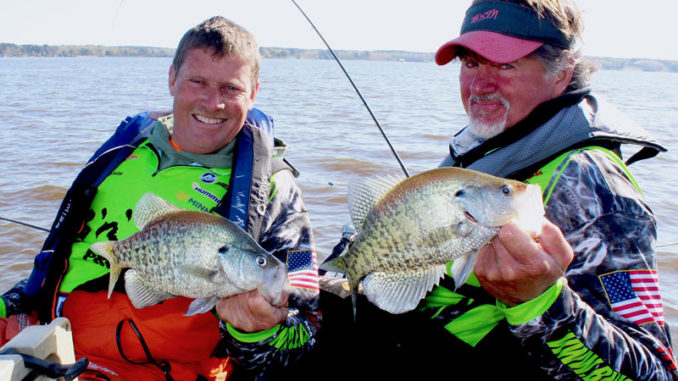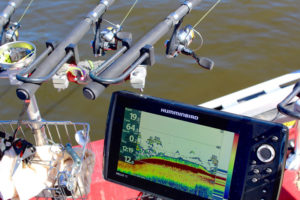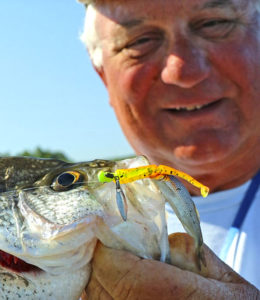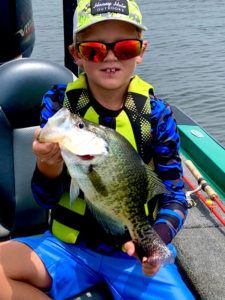
December isn’t the most-popular month to catch crappie. The good fish aren’t always easy to find. Hunting, football and the holidays have everybody busy. Many anglers just have too much to do. But stalking crappie in December can be one of the best fishing gifts anglers can give themselves.
Crappie tend to gather up in deeper water along channels and old river beds. In smaller bodies of water, they try to find the deepest water. In other lakes, crappie aren’t far from where they are caught most of the rest of the year. It boils down to the fact that crappie will go wherever baitfish take them. They head to wherever they hear the dinner bell ring.
We talked to Santa, and he doesn’t have time to crappie fish, either, but he told us to talk to some of his favorite crappie fishermen on his “nice” list and get their take on Christmas crappie. Here’s their present to us — tips and seasons greetings for December crappie fishing.

Capps and Coleman
In the world of crappie fishing, Ronnie Capps and Steve Coleman, both from Tiptonville, Tenn., are like peanut butter and jelly. Everybody’s heard of the most-dominant duo in the history of competitive crappie fishing.
You’ve heard the line, “We’re gonna need a bigger boat?” Well, Capps and Coleman must often find themselves thinking “We’re gonna need a bigger trophy room.” They have won just about every tournament and angling title there is out there.
“Through the winter, it’s a fun time to catch fish” Capps said. “People get cold hands and don’t want to fight the weather, but it’s great fishing. The fish get a little more lethargic, which is good, because they won’t run from you as bad — and they’ll still bite. The electronics today is so good you can go to an area, and if you don’t see fish in just a few minutes, you probably need to crank up and go somewhere else.

“With the new (electronics), we are learning every day. My newest tip is that you need to watch fish closely and figure out how far they can see the bait,” he said. “They’ll make a little reaction when they see it. When they do, stop the bait. Don’t get any closer. If they see it, make them come to you. When you do that, you’ll get close to 110% hookups. If you drop it too close, you’ll spook them or be in an awkward spot and maybe not get a good hookset.”
Capps also said you need to figure out the optimum bait size, too. For the most part, he downsizes everything, but sometimes, when it’s cold, they’ll like a big bait. Above everything else, he said, learn your equipment and how to fish it. That takes time. And learn pinpoint boat control. Without it, you won’t catch nearly as many.
Coleman said fishing deep requires getting your bait down where the crappie are and keeping it there. There’s no better way to do that, he said, than fishing a double-minnow rig with a big weight.
“Most fishermen set their bait the right depth, but a lot of them don’t have enough weight to keep the bait where the fish are,” he said. “When you move your bait, it is going to come up a foot or two, especially spider-rigging. Don’t take yourself out of the game by doing that.
“And as with almost anything, two is better than one, so we fish the double-minnow rig a lot anytime we are in deeper water. You can set one bait a foot or 18 inches apart from the other and cover a lot more water.”
Nobody knows this technique better than Capps and Coleman. B’n’M even sells a pre-rigged, double-minnow rig named for the two. It comes in several choices, with different size weights for different depths.

The ‘Crappie Mates’
Dan and Sue Dannenmueller of Wetumpka, Ala., are one of several husband/wife teams fishing pro crappie circuits. They are among the top crappie anglers and active ambassadors for the sport. He is a past national champion and a regular presenter at Crappie University and other seminars. He and his wife teamed up to form Crappie Mates and fish together professionally.
Experience on all kinds of lakes has taught Dan Dannenmueller to be versatile. When the water is cold, he has five techniques he uses to catch crappie:
- Vertically jigging small spoons like a Thundermist Singnose in gold or silver;
- Fishing blade baits like Johnson Thinfishers;
- Vertically jigging small jigs like Bobby Garland Itty Bitty heads and jigs;
- Drop-shotting Blakemore’s Live Shotn’s;
- Casting a Road Runner Classic Marabou.
Of those, casting and winding the Road Runner is the easiest for inexperienced fishermen. Dannenmueller fishes all of these baits close to stumps, brush or contour breaks with a slow presentation and very little movement. He finds the right spot using his Garmin Livescope.
“When casting the Road Runner for deep fish, you just find the depth fish are at, then cast the bait, count it down a second per foot, and slowly retrieve it. The fish will nail it in 20 feet of water just like they will in two.”
Sue Dannenmueller said she and her husband have the best luck in the warmest water in the lake, even in the winter. That’s her tip.
“Lakes cool from the shallower, upper reaches first, to the deep southern areas last,” she said. “The more-active fish will be in the higher water temperatures. Look for areas with lots of baitfish. You can do that (with) electronics or watch for water birds that feed on shad. They will also give these areas away. The fish will be roaming with the schools for shad.”
One more good tip. If your lake has bridges, they are crappie havens in the winter.

Like father, like son
Father/son crappie-fishing teams are also growing in numbers. One that is unique is the team of Trey and Tucker Underwood of Ruston, La. They catch fish like two seasoned veterans, but Tucker is only 8 years old. Recently, they finished in the top 10 in two national tournaments and in the top 25 in the Crappie Masters National Championship. If you think Tucker is just the “net man,” think again.
“The highlight of my national championship was watching Tucker catch their biggest fish of the tournament about 30 yards from me,” another crappie pro said. “He did it all by himself while dad was at the other end of the boat.”
Tucker Underwood is already driving the boat, sitting up front and watching the electronics. The big fish he caught in the national championship tournament weighed 2.02 pounds — his first 2-pound slab. He landed four of the team’s 7-fish limit.
“That was the most exciting thing for me,” Tucker Underwood said. “It’s the first 2-pounder I ever caught, and it came in the national championship.”
He was single-poling on that fish, but his favorite technique is spider-rigging. In fact, that’s his best tip to other fishermen.
“I like to spider-rig, because you have more than one bait in the water at a time. I like to hold the pole in my hand when I can, because you feel the bite better and you miss fewer fish,” he said. “I also like fishing the double-minnow rig, too. I caught that big fish differently. I saw the fish out from the boat on the electronics, and I cast a small purple/chartreuse tail bladed jig out past the fish and reeled it right in front of the fish. The fish nailed it. They had been spooky, so I thought that was the best way to get him. He nailed it.”
Trey Underwood said that when the fish go deep and congregate, there is usually a crowd. He likes to go fish in those areas when he’s after numbers, but when he goes for big fish in colder months, he eases away from the crowd and tries to find fish in deeper sloughs off the main area everybody else is fishing.
“Two things I like to do is get away from where the bigger schools are, and I like to upsize my bait,” he said. “I use bigger jigs and get away from lighter, hair jigs and go big like 21/2- and 3-inch tails. Sometimes, I’ll even tip it with a minnow. This time of year, the fish are wanting to eat. The bigger fish like bigger baits.”
He also uses bigger weights in cold weather.
“I’ll even go to a 1/4-ounce jighead sometimes, because I want to get the bait down there as quickly as I can, keep it down there where the fish are and then quickly move to the next spot and do the same thing over again,” he said.


